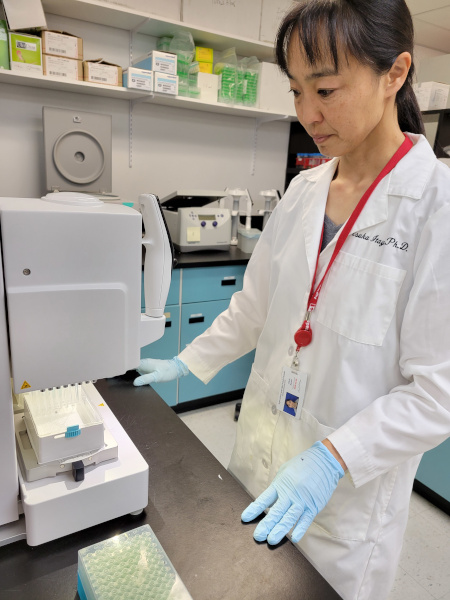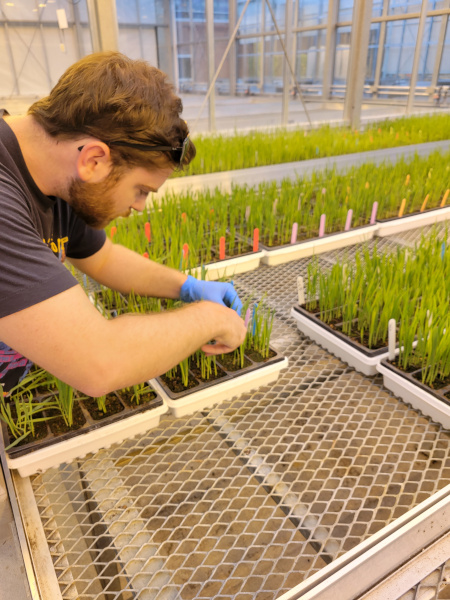For more information
Media Relations
Agriculture and Agri-Food Canada
1-866-345-7972
aafc.mediarelations-relationsmedias.aac@agr.gc.ca
Oats are an ancient and important cereal crop. Along with wheat, barley and rice, they make up a key group of staple foods that are essential to global food security. In recent years, oats have seen an increase in popularity and are poised to become even more important to the global effort to feed a growing world population with sustainable and healthy food.
At Agriculture and Agri-Food Canada’s Ottawa, Brandon, and Saskatoon Research and Development Centres, research scientists Dr. Nicholas Tinker, Dr. Wubishet Bekele, Dr. Yong-Bi Fu, and their research partners are helping bring this climate-smart crop to the next level, and recently announced a breakthrough: the creation of the world’s first reference genome for oats, and its implication for oat breeding.
A unique crop
In addition to being delicious, oats have an outstanding nutritional profile. The star of the show is a unique compound in oats called beta-glucan, a type of soluble fibre that has been shown to manage cholesterol, improve heart health, and avoid causing a large spike in blood sugar levels when eaten. As if that weren’t enough, oats are high in protein, gluten-free, and keep us feeling full for a long time.
But despite its superfood status, it took a while for oats to get the attention they deserve. For centuries, oats were grown mainly as fodder for animals, and only rarely as a human food.
Fast-forward to the present, and it’s a completely different reality. Chefs can choose from a wide range of prepared oat products from rolled, to quick, to steel-cut and beyond. Fitness influencers share their favourite recipes for “overnight oats” on social media, and baristas in downtown coffeeshops prepare vegan lattes topped with foamy oat milk.
There’s no doubt that oats are on a roll – and it’s Canadian research and farming savvy that have helped make it happen.
Superfood sequencing
Working with an international team of researchers, AAFC scientists Dr. Tinker, Dr. Bekele, and Dr. Fu published a landmark study in the journal Nature announcing that they had successfully sequenced and characterized the entire oat genome. In a companion paper, Dr. Tinker and Dr. Bekele led an AAFC team in demonstrating some of the implications of this new reference genome in oat improvement. This is of tremendous value to plant breeders who can use this genomic map to improve their breeding programs. But how does this work?
The practice of plant breeding is as old as farming itself. In its simplest form, it means saving seeds from the best-performing plants in the hopes of increasing the quality of the next harvest. Today, plant breeders rely on complex genetics work that allows them to speed this process up drastically. For example, researchers can take a tissue sample from a plant and test its DNA, to measure with a kind of “point system” that shows how likely the offspring from that plant can meet the high standards required for a new plant variety: useful traits including better yields, higher protein content, or the ability to withstand drought and disease. In addition to its speed, this method of genomic selection is also more reliable than using only the physical appearance of the plant to judge its quality. When it comes to how a plant will ultimately perform, looks can be deceiving. But to achieve marker-assisted selection, researchers must first be able to create genetic profiles using genome-wide snippets of DNA.
That’s where Dr. Tinker and Dr. Bekele come in. Working together with their AAFC counterparts across the country, as well as with oat researchers around the world, the team worked for years testing and evaluating thousands of oat varieties and cataloguing their genetic profiles. Using powerful sequence analysis software, they developed a consensus linkage map for oats: a crude blueprint of the 21 oat linkage groups (chromosomes). This map was then instrumental in assembling and ordering the sequences into 21 oat chromosomes of the cultivar “Sang” for the Nature publication.
This discovery puts a powerful new tool into the hands of plant breeders, who can use it to speed up the development of new and improved oat varieties. The average breeding cycle for cereal crops lasts up to 12 years and involves a painstaking process of evaluation that slowly refines each generation of plants until only the best-performing variety is left standing. For example, a researcher or breeder interested in one particular disease-resistance gene controlled by a few genes can develop diagnostic molecular markers for that gene in the chromosomal region. Researchers will now be able to test the DNA for these markers in each variety at the outset of the process, returning the best candidates to the top of the breeding pipeline while the variety continues in the process of being developed for use by farmers. This can shorten the breeding process by a year or more, but more importantly, it can allow breeders to reliably select for specific or future agro-climatic environments at a stage in the breeding program when it is not possible to grow all seeds in those environments.
“As we have shown in the Nature and the companion paper, I am excited by the opportunity opened up by the availability of the reference genome sequence to understand the level of large-scale chromosomal variations in oat germplasm. Such information will guide our future genomics-assisted optimum parental selection procedures.”
– Dr. Wubishet Bekele, Research Scientist, Agriculture and Agri-Food Canada
The achievement at the AAFC Ottawa Research and Development Centre is even more significant because the oat genome is extremely complicated, and nearly four times as large as the human genome. It is also a rare example of a “triple genome” that evolved from multiple wild relatives combining to form a massive genetic string. This means the sequencing process is like doing three large, complicated jigsaw puzzles at the same time with the pieces from all three boxes mixed together! The oat genome also has an unusually high degree of genetic variability, meaning that it easily tolerates rearrangements of genetic material among its chromosomes, again a result of oats crossing naturally in the wild for millennia.
“I have spent most of my career studying genetic variation in oats, but the level of genome diversity that we can now see in cultivated and wild oat is beyond what we expected. Together with an International team of scientists, we are now knee-deep in analyzing 30 wild and cultivated oat genomes from around the globe as a follow up to the Nature publication.”
– Dr. Nicholas Tinker, Research Scientist, Agriculture and Agri-Food Canada
A boost for global food security
This discovery is a step forward in the race to feed a growing world population with nutritious and sustainable food. In addition to being very healthy, oats have been proven to be very filling (this is called having a high “satiety” in food science terms). A big part of the challenge of feeding an estimated global population of 9.7 billion people by 2050 is the ability to produce more food from the same amount of farmland, so a crop like oats that help feed us as efficiently as possible is a real benefit.
It also represents an opportunity for Canadian agriculture to become an even bigger driver of our economy. Canada is the world’s leading exporter of oats, with most of that production coming from the Prairie powerhouse of Saskatchewan. Demand is rising for healthy food that is produced using sustainable farming practices, and Canada is ready to deliver. Put Canadian oat growers together with the cutting-edge research being done at AAFC, and you have the makings of a cereal dream team that can help boost the economy for years to come.
Thanks to the hard work of dedicated AAFC researchers like Dr. Tinker and Dr. Bekele, Canadian farmers can benefit from new oat varieties that are better suited to a changing climate, require fewer inputs like water and fertilizer, and boast improved nutritional profiles. And in the best tradition of AAFC research, this discovery was immediately made available to researchers around the world free of charge, who can now use this genetic reference map in their own breeding programs. The end result of all this complex science is simple – more and better oats. That’s an achievement worth toasting with a glass of milk and an oatmeal cookie!
Key benefits
- The research team at the ORDC worked closely with their counterparts at the Brandon Research and Development Centre and partners around the world to create the world’s first genetic reference map for oats. This has further cemented Canada’s status as an innovator and global leader in sustainable agriculture.
- The genetic reference map will enable oat breeders to speed up the process of their research projects and produce results much faster. This has the potential to increase investment in the crop by increasing the number of projects which can follow a standard 3- to 5-year research cycle.
- In Canada, oats are an $8 billion industry with a product that is recognized around the world for its superior quality. Canada is the world’s largest exporter of oats and is ready to benefit from increased investment in this key crop.
Photo gallery

Drs. Nicholas Tinker and Wubishet Bekele

Researcher preparing oat samples for DNA sequencing

Oat seedlings